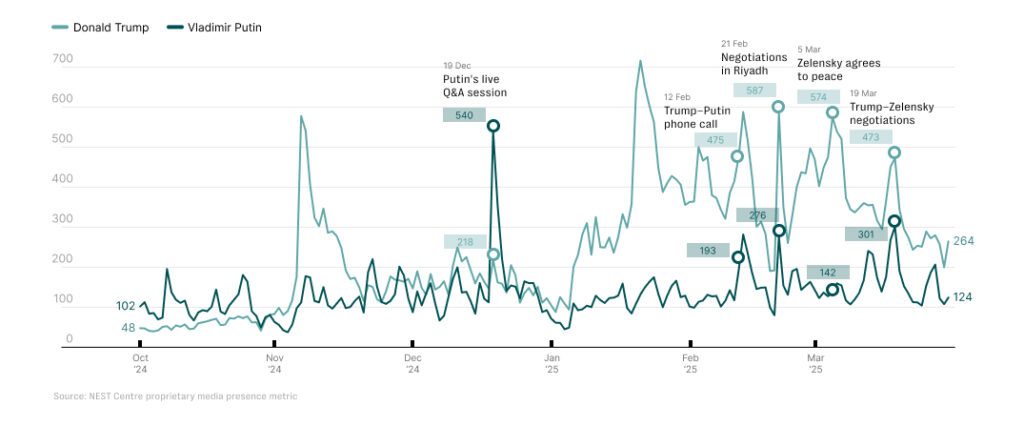Vladimir Putin’s recent public remarks in Murmansk, in Russia’s north – delivered against the backdrop of a regional forum and the launch of a new nuclear submarine – offer a window into the Kremlin’s evolving strategy. They signal Russia’s relentless intent to entrench a hierarchical model of international politics, based on spheres of influence and the rejection of universal norms.
Reasserting spheres of influence
Putin’s interventions in Murmansk were carefully calibrated for multiple audiences. While intended in part for domestic consumption, they were also directed at foreign observers – particularly in the United States, where informal channels between Republican circles close to President Trump and Moscow remain active.
The core of Putin’s message was familiar. He reiterated the Kremlin’s vision of a global order shaped by power politics rather than by international law or multilateral institutions. This is not a new proposition: the Kremlin has long argued for a system in which the major powers agree informal ‘rules of the game’ and smaller states are expected to acquiesce to their respective spheres of influence.
Putin’s references to the 19th-century sale of Alaska and past American interest in Greenland underscore this transactional, hierarchical worldview. In Moscow’s reading, stability arises not from universal norms but from negotiated understandings between great powers – an approach that sidelines the sovereignty and agency of smaller states.
Selective détente
Elements of Putin’s Murmansk speech also drew on the language of Cold War diplomacy. Echoes of the 1975 Helsinki Accords were evident in his emphasis on non-interference and limited de-escalation between major powers. However, the Kremlin’s current interpretation of détente is highly selective.
In Moscow’s view, the inclusion of human rights provisions within the comprehensive concept of European security was a strategic error by the Soviet leadership – one that contributed to the eventual erosion of Soviet authority. Today, the Kremlin is intent on avoiding similar concessions.
The Arctic as a testing ground
The choice of Murmansk as the stage for this message was no coincidence. For Moscow, the Arctic is a proving ground for its preferred model of international order. Russia is signalling a conditional willingness to engage in cooperation in the region, including with the United States, but only on terms that acknowledge its special status.
This posture is underpinned by significant long-term investments in Arctic infrastructure, a naval development strategy stretching to 2050, and the expansion of the Northern Sea Route. Informally, Vladimir Putin floated the notion of reciprocal recognition of territorial interests – including American claims in Greenland – in exchange for international acceptance of Moscow’s ambitions in Arctic waters and infrastructure.
Beyond the United States, this messaging also targets the Nordic states. Finland, Sweden and Denmark are being presented with a dual signal: an openness to regional cooperation, coupled with an explicit willingness to use force if Russian interests are challenged. Any such cooperation, the Kremlin suggests, must be based on power balances – not universal principles or guarantees of political autonomy.
Washington’s ‘tactical noise’?
The Kremlin’s approach helps explain why Moscow is unlikely to interpret recent statements by US President Donald Trump – including threats of secondary sanctions on Russian oil exports – as serious instruments of pressure. Russian policymakers view such rhetoric primarily as a reflection of US domestic politics rather than a coherent strategy of containment.
Major buyers of Russian oil, such as China and India, have already indicated that they do not intend to comply with Washington’s sanctions threats. From Moscow’s perspective, the true pressure point would be the continuation of US military assistance to Ukraine. However, this is precisely the area where the Trump administration has so far avoided decisive action, leaving open the possibility of strategic bargaining.
Preparing for a ‘managed conflict’
This calculus reflects a broader shift in the Kremlin’s posture towards the war in Ukraine and its confrontation with the West. Russian planners are preparing for a long-term, ‘managed’ conflict – one in which military confrontation is sustained but calibrated, and societal pressures at home are carefully contained. Moscow anticipates that by summer 2025, the current US military aid package to Ukraine may expire without renewal. Should Congress fail to approve a new tranche of assistance, the Kremlin would likely view this as an opportunity to escalate military operations.
At the same time, the Russian leadership is taking steps to mitigate the domestic costs of prolonged war. It has expanded military recruitment and mobilisation but is also signalling the possibility of partial demobilisation and increased welfare support for veterans. Public initiatives to honour military service have been rolled out across the country. This reflects a hybrid approach: sustaining readiness for long-term confrontation while embedding the war in Russia’s political and social fabric.
The Trump factor
A less visible but strategically important trend is unfolding in the information domain. Monitoring of Russian-language media – both social and traditional – indicates that Donald Trump now receives more coverage than Putin himself – even during periods of relative quiet in US politics. For sections of Russia’s conservative and nationalist audience, Trump has become a symbolic figure: blunt, combative, and dismissive of liberal internationalism.
Fig.1. Media Presence Index of Vladimir Putin and Donald Trump (October 2024 – March 2025)

Notably, over 70% of the analysed sources are in Russian and primarily drawn from social media platforms such as Telegram, VK, and X. This means the index specifically captures media presence within a predominantly Russian media environment. Although the index does not use conventional units, a higher score represents greater media prominence.
This alignment, however, may also carry risks for the Kremlin. Should Trump shift his rhetoric and turn against Moscow – particularly in his trademark style of public ridicule – he could undermine Putin’s carefully cultivated image of authority. In a political system that depends heavily on perceptions of presidential strength, such symbolic blows could have destabilising effects.
In sum, the ‘Murmansk message’ is not merely a regional signal or a rhetorical flourish. It is part of a broader strategy in which the Kremlin seeks to entrench a power-based international order and position itself as an indispensable actor in European and Arctic security.

